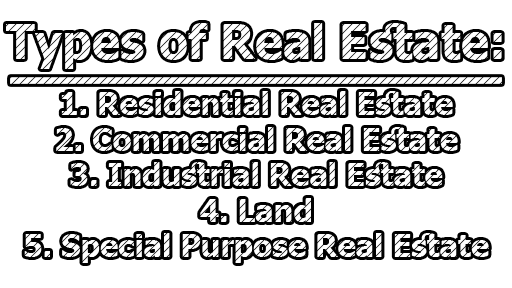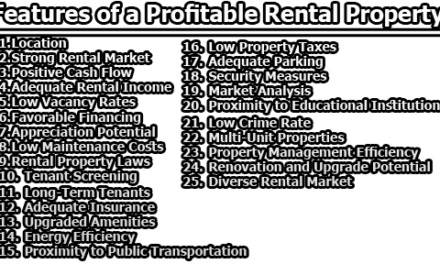Real Estate:
Real estate refers to property consisting of land, buildings, and natural resources, including the air and water rights above the land and the underground rights below it. It encompasses a wide range of properties, such as residential homes, commercial buildings, industrial facilities, vacant land, and more. Real estate is a significant asset class and plays a crucial role in the economy. It serves various purposes, including providing housing for individuals and families, accommodating businesses and commercial activities, and serving as an investment vehicle for individuals and institutions. The real estate industry involves various professionals and activities, including real estate developers, agents, brokers, investors, property managers, appraisers, and lenders. These professionals are involved in activities such as buying, selling, leasing, developing, managing, and financing real estate properties. Investing in real estate can be done through various strategies, such as purchasing properties for rental income, buying and selling properties for profit (flipping), investing in real estate investment trusts (REITs), or participating in real estate development projects. In short, real estate encompasses the physical assets and properties that form the built environment and contribute to economic and social activities. In this article, we will know about different types of real estate with examples.
Types of Real Estate:
Real estate is a vast and diverse asset class that encompasses a wide range of properties and land. It plays a crucial role in the economy, providing housing, commercial spaces, and infrastructure for various activities. Understanding the different types of real estate is essential for investors, developers, and individuals looking to navigate the market effectively. Here, we will explore the main types of real estate, including residential, commercial, industrial, land, and special-purpose properties.
- Residential Real Estate: Residential real estate comprises properties primarily used as homes for individuals and families. It includes various housing options, such as:
- Single-Family Homes: These properties consist of one dwelling unit and are designed to accommodate a single family. They can range from small cottages to large mansions, offering a range of sizes and architectural styles.
- Multi-Family Homes: These properties contain multiple residential units, allowing for the accommodation of multiple families or individuals. Examples include duplexes (two units), triplexes (three units), and apartment complexes (multiple units in a single building or complex).
- Condominiums: Condos are individually owned units within a larger complex or building. Owners have exclusive ownership of their units and shared ownership of common areas and facilities, such as elevators, swimming pools, or parking lots.
- Cooperative Housing: In a cooperative (co-op), residents own shares in a corporation that owns the property. Each shareholder has the right to occupy a specific unit. Co-ops often have strict rules and regulations regarding ownership and residency.
- Vacation Homes: These properties are typically secondary residences used for vacations or recreational purposes. They are often located in desirable vacation destinations such as beachfront areas, mountains, or scenic landscapes.
- Commercial Real Estate: Commercial real estate refers to properties used for business and commercial purposes. These properties can be used for various types of commercial activities, such as:
- Office Buildings: These properties are designed for office use and accommodate businesses and professional services. They can range from small office spaces to large high-rise buildings.
- Retail Spaces: Retail properties include storefronts, shopping malls, strip malls, and other spaces used for retail businesses, such as clothing stores, grocery stores, restaurants, or cafes.
- Hospitality Properties: This category includes hotels, motels, resorts, and other lodging facilities that cater to travelers and tourists.
- Restaurants and Food Service: Properties that house restaurants, cafes, fast-food chains, or other food-related businesses.
- Mixed-Use Developments: These properties combine multiple types of uses within a single development. For example, a mixed-use building may have commercial spaces on the lower floors and residential units on the upper floors.
- Industrial Real Estate: Industrial real estate pertains to properties used for industrial purposes, such as manufacturing, production, warehousing, and distribution. Examples of industrial real estate include:
- Manufacturing Facilities: These properties are used for the production and assembly of goods. They often have specialized infrastructure, equipment, and layouts to accommodate manufacturing processes.
- Warehouses and Distribution Centers: These properties provide storage and distribution facilities for goods and products. They can range from small warehouses to large distribution centers with advanced logistics systems.
- Flex Spaces: Flex spaces are versatile properties that can be used for various purposes, such as a combination of manufacturing, office, and storage spaces. They offer flexibility to cater to different industrial needs.
- Industrial Parks: These are planned areas that accommodate multiple industrial facilities. They often provide shared amenities, infrastructure, and transportation access to support industrial operations.
- Land: Land refers to parcels of property without any structures or improvements. It can have various purposes and potential uses, including:
- Residential Land: Parcels of land intended for residential development. They can be subdivided into lots or used for single-family homes or multi-family housing.
- Commercial Land: Land designated for commercial development, such as office buildings, retail centers, or hospitality properties.
- Agricultural Land: Land used for farming, cultivating crops, or raising livestock.
- Industrial Land: Land reserved for industrial development, such as manufacturing facilities, warehouses, or distribution centers.
- Recreational Land: Land intended for recreational purposes, such as parks, sports fields, golf courses, or hiking trails.
- Development Land: Undeveloped land with the potential for future development. It may be zoned for residential, commercial, or mixed-use purposes.
- Conservation Land: Land preserved for environmental or conservation purposes, such as wildlife sanctuaries, nature reserves, or protected areas.
- Waterfront Land: Land located along bodies of water, such as lakes, rivers, or coastlines. It can have recreational, residential, or commercial value.
- Special Purpose Real Estate: Special purpose real estate refers to properties with unique and specific uses that are not easily adaptable for other purposes. These properties are designed to serve a specialized function. Examples include:
- Educational Facilities: Properties used for schools, colleges, universities, and other educational institutions. They can range from elementary schools to university campuses.
- Healthcare Facilities: Properties such as hospitals, clinics, nursing homes, and medical offices that cater to healthcare services. They provide spaces for medical treatment, diagnosis, and patient care.
- Religious Buildings: Properties used for religious purposes, such as churches, mosques, temples, or synagogues. They serve as places of worship and community gathering for religious groups.
- Government Buildings: Properties owned and used by government entities, including courthouses, municipal buildings, administrative offices, or military bases.
- Sports and Entertainment Venues: Properties like stadiums, arenas, theaters, concert halls, and amusement parks designed for sports events, concerts, performances, or recreational activities.
- Airports and Transportation Infrastructure: Properties used for airports, railway stations, seaports, or bus terminals, facilitating transportation and travel.
- Utilities and Infrastructure: Properties associated with utilities, such as power plants, water treatment facilities, telecommunication towers, or sewage treatment plants.
- Vacant Buildings: Abandoned or unused properties that may require redevelopment or repurposing for other uses. They can provide opportunities for adaptive reuse or renovation.
- Historic Properties: Buildings or sites with historical significance that are preserved for cultural or heritage purposes. They may have architectural, cultural, or historical value.
- Natural Resource Properties: Properties that encompass natural resources such as forests, mines, oil fields, or water bodies. They are often used for extraction or conservation purposes.
- Specialized Facilities: Properties designed for specific purposes, such as data centers, research laboratories, correctional facilities, or sports training facilities.
It is apparent that real estate is a multifaceted and dynamic asset class that encompasses a diverse range of properties and land. Understanding the various types of real estate is vital for investors, developers, and individuals seeking to make informed decisions in the market. By recognizing the specific characteristics, opportunities, and regulations associated with each type, stakeholders can effectively leverage real estate assets to achieve their goals. It is important to note that the real estate market is influenced by factors such as location, economic conditions, and societal trends. Therefore, conducting thorough research, seeking professional guidance, and staying informed about market dynamics are essential for success in the real estate industry. Overall, real estate provides a foundation for our homes, businesses, and communities. Its diverse nature offers endless opportunities for investment, development, and innovation, shaping the built environment that surrounds us.

Assistant Teacher at Zinzira Pir Mohammad Pilot School and College










